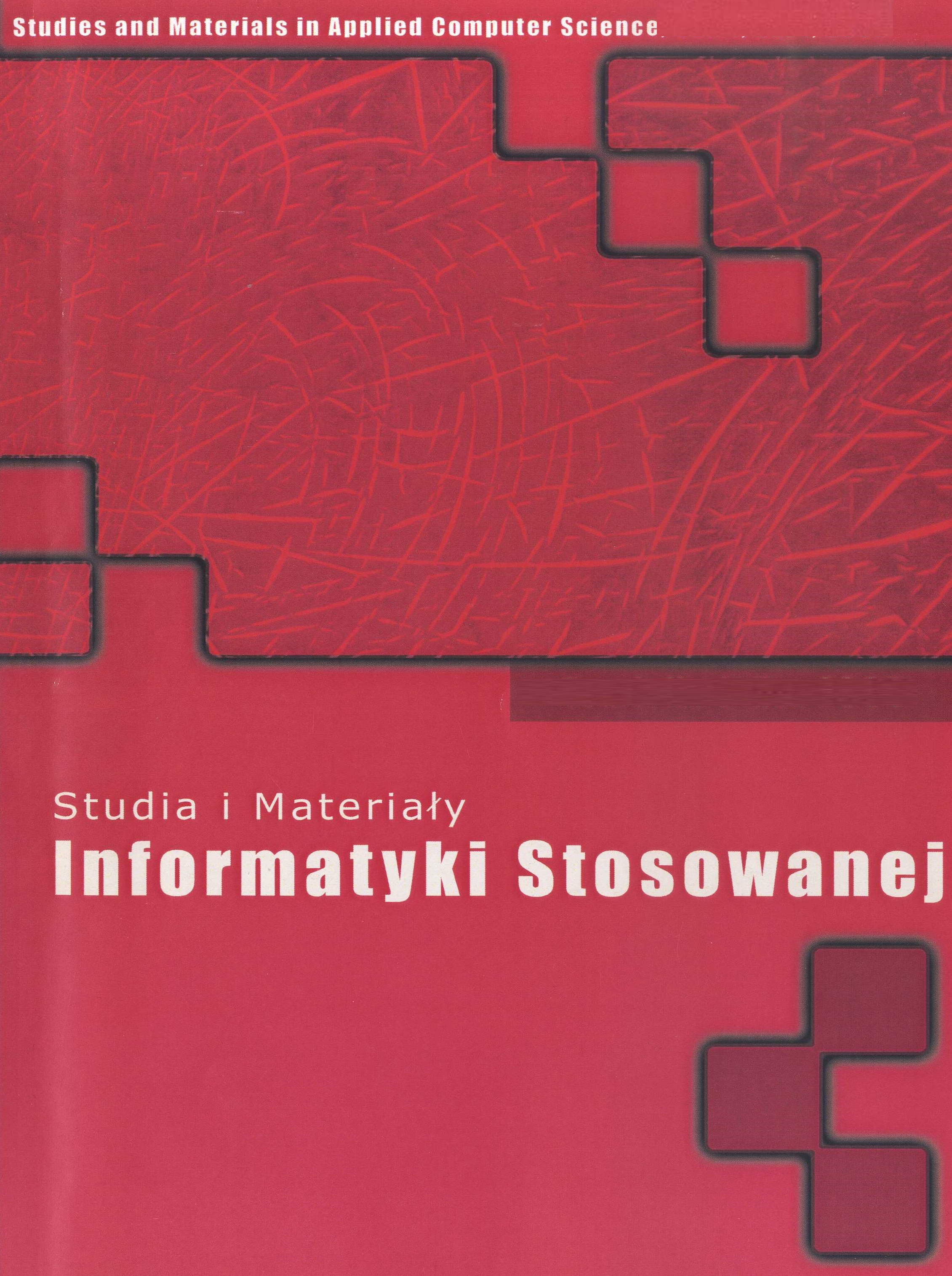Objawy wypalenia zawodowego jako podstawa modelu obliczeniowego
DOI:
https://doi.org/10.34767/SIMIS.2021.03.03Słowa kluczowe:
inteligencja obliczeniowa, sztuczne sieci neuronowe, model obliczeniowy, wypalenie zawodowe, zaangażowanie w pracę, motywacja do pracyAbstrakt
Obecnym wyzwaniem jest zbadanie i optymalizacja obliczeniowych miar wypalenia zawodowego w celu obiektywnego określenia najlepszego sposobu obliczania satysfakcji z pracy, wypalenia zawodowego i predyktorów zamiaru odejścia z pracy w różnych grupach zawodowych.Celem badań prezentowanych w artykule był przegląd badań w zakresie obliczeniowego określanie zależności między doświadczaniem stresu w pracy a występowaniem objawów wypalenia zawodowego.
Bibliografia
Schultz M.A., Walden R.L., Cato K., Coviak C, P., Cruz C., DeAgostino F., Douthit B. J., Forbes T., Gao G., Lee M. A. , Lekan D., Wieben A., Jeffery A. D. Science Methods for Nursing-Relevant Patient Outcomes and Clinical Processes: The 2019 Literature Year in Review. Comput Inform Nurs. 2021; 39(11):654-667.
Dutra H. S., Guirardello E. B., Li Y., Cimiotti J. P. Nurse Burnout Revisited: A Comparison of Computational Methods. J Nurs Meas. 2019; 27(1):E17-E33. doi:10.1891/1061-3749.27.1.E17.
Blain B., Schmit C., Aubry A., Hausswirth C., Le Meur Y., Pessiglione M. Neuro-computational Impact of Physical Training Overload on Economic DecisionMaking. Curr Biol 2019; 29(19):3289-3297.e4. doi: 10.1016/j.cub.2019.08.054.
Müller T., Klein-Flügge M. C., Manohar S. G., Husain M. Neural and computational mechanisms of momentary fatigue and persistence in effort-based choice. Apps MAJ. Nat Commun. 2021; 12(1):4593. doi: 10.1038/s41467-021-24927-7.
Jurgelis M., Chong W. B., Atkins K. J., Cooper P. S., Coxon J. P., Chong T. T. Heightened effort discounting is a common feature of both apathy and fatigue. Sci Rep. 2021; 11(1):22283. doi: 10.1038/s41598-021- 01287-2.
González-Morales M. G., Peiró J. M., Rodríguez I., Bliese P. D. Perceived collective burnout: a multilevel explanation of burnout. Anxiety Stress Coping. 2012; 25(1):43-61.
Maslach C., Leiter M. P. Understanding the burnout experience: recent research and its implications for psychiatry. World Psychiatry. 2016; 15(2):103-11.
Patel R. M., Bartholomew J. Impact of Job Resources and Job Demands on Burnout among Physical Therapy Providers. Int J Environ Res Public Health. 2021; 18(23):12521.
Moroń M., Yildirim M., Jach Ł., Nowakowska J., Atlas K. Exhausted due to the pandemic: Validation of Coronavirus Stress Measure and COVID-19 Burnout Scale in a Polish sample. Curr Psychol. 2021 Nov 26:1- 10.
Zhang Y., Steege L. M., Pavek K. U., Brown R. L., Zhang Y. Identifying patterns of occupational stress trajectories among newly graduated nurses: A longitudinal study. Int J Nurs Stud. 2019; 99:103332.
Salari N., Khazaie H., Hosseinian-Far A., KhalediPaveh B., Kazeminia M., Mohammadi M., Shohaimi S., Daneshkhah A., Eskandari S. The prevalence of stress, anxiety and depression within front-line healthcare workers caring for COVID-19 patients: a systematic review and meta-regression. Hum Resour Health. 2020; 18(1):100.
Smith M. J., Conway F. T., Karsh B. T. Occupational stress in human computer interaction. Ind Health. 1999; 37(2):157-73.
Nakano T., Hayashi T., Nakagawa T., Honda T., Owada S., Endo H., Tatemichi M. Increased Incidence of Visual Field Abnormalities as Determined by Frequency Doubling Technology Perimetry in High Computer Users Among Japanese Workers: A Retrospective Cohort Study. J Epidemiol. 2018;28(4):214-219.
Dickin D. C., Surowiec R. K., Wang H. Energy expenditure and muscular activation patterns through active sitting on compliant surfaces. J Sport Health Sci. 2017; 6(2):207-212.
Honda T., Nakagawa T., Watanabe Y., Hayashi T., Nakano T., Horie S., Tatemichi M. Association between Information and Communication Technology use and Ocular Axial Length Elongation among Middle-Aged Male Workers. Sci Rep. 2019; 9(1):17489.
Chow Y., Masiak J., Mikołajewska E., Mikołajewski D., Wójcik G. M., Wallace B., Eugene A., Olajossy M. Limbic brain structures and burnout - A systematic review. Advances in Medical Sciences 2018; 63(1):192-198
Lehmann M. J., Lormes W., Opitz-Gress A., Steinacker J. M., Netzer N., Foster C., Gastmann U. Training and overtraining: an overview and experimental results in endurance sports. J Sports Med Phys Fitness. 1997; 37(1):7-17.
Blain B., Hollard G., Pessiglione M. Neural mechanisms underlying the impact of daylong cognitive work on economic decisions. Proc Natl Acad Sci U S A. 2016; 113(25):6967-72.
Gomes A. R., Faria S., Vilela C. Anxiety and burnout in young athletes: The mediating role of cognitive appraisal. Scand J Med Sci Sports. 2017; 27(12):2116- 2126.
Kable J. W., Caulfield M. K., Falcone M., McConnellM., Bernardo L., Parthasarathi T., Cooper N., Ashare R., Audrain-McGovern J., Hornik R., Diefenbach P., Lee F. J., Lerman C. No Effect of Commercial Cognitive Training on Brain Activity, Choice Behavior,or Cognitive Performance. J Neurosci. 2017; 37(31):7390-7402.
Sęk H. Poznawcze i kompetencyjne uwarunkowania wypalenia w pracy z chorymi, Postępy Psychiatrii i Neurologii. 2005; 14:95.
Pérez-Fuentes MdC, Molero Jurado MdM, Martos Martínez Á., Gázquez Linares J. J. New Burnout Evaluation Model Based on the Brief Burnout Questionnaire: Psychometric Properties for Nursing. International Journal of Environmental Research and Public Health. 2018; 15(12):2718.
Nursalam N.., Fibriansari R. D., Yuwono S. R., Hadi M., Efendi F., Bushy A. Development of an empowerment model for burnout syndrome and quality of nursing work life in Indonesia, International Journal of Nursing Sciences, 2018; 5(4):390-395.
Puertas-Molero P., Zurita-Ortega F., Chacón-Cuberos R., Martínez-Martínez A., Castro-Sánchez M., González-Valero G. An Explanatory Model of Emotional Intelligence and Its Association with Stress, Burnout Syndrome, and Non-Verbal Communication in the University Teachers. Journal of Clinical Medicine. 2018; 7(12):524.

